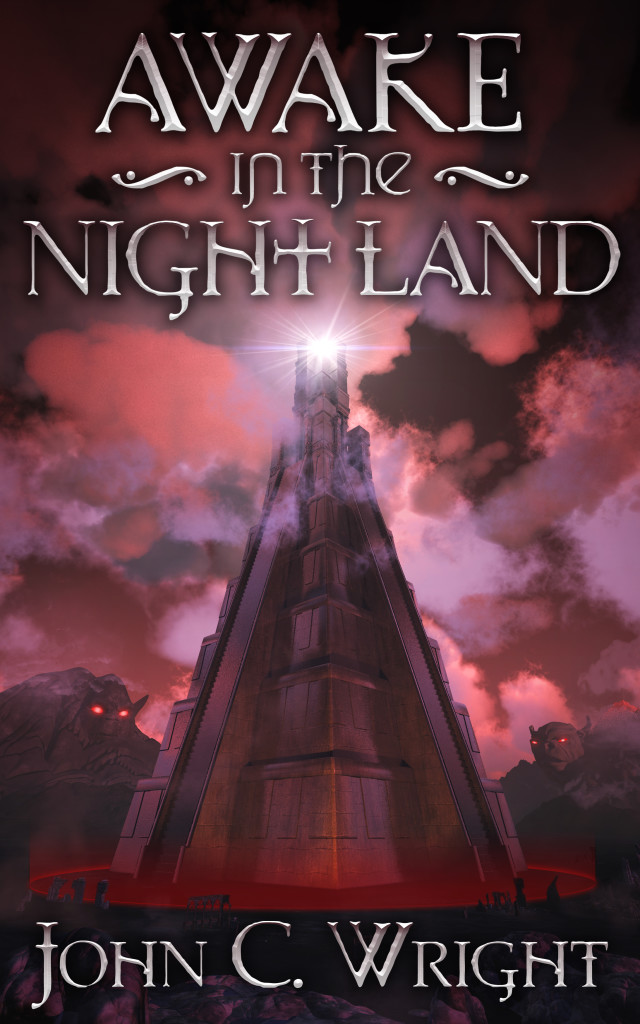Monday the 14th is NIGHT LAND day — and the Feast of St. Bezenet
I am pleased and humbled to announce that my anthology, AWAKE IN THE NIGHT LAND published by Castalia House is purchase as of Monday, April 14th.
It is available now for early purchase here: http://www.amazon.com/Awake-Night-Land-John-Wright-ebook/dp/B00JM98V60
This is a collection of my various tales and short novels written in homage to THE NIGHT LAND by William Hope Hodgson.
The four stories are
- Awake in the Night which has appeared previously in William Hope Hodgson’s NIGHT LANDS Volume I: Eternal Love, Andy W. Robertson (Editor), The Year’s Best SCIENCE FICTION, Gardner Dozois (Editor), Best Short Novels 2004, Jonathan Strahan (Editor)
- Cry of the Night Hound
- Silence of the Night
- Last of All Suns has appeared previously in William Hope Hodgson’s NIGHT LANDS Volume II: Nightmares of the Fall, Andy W. Robertson (Editor)
As you can see, these tales have been out of circulation for ten years, and it is high time they were returned to the public. We have only until the year AD Twenty Two Million to abort the onset of these ominous events.
No doubt the candid reader is wondering why the 14 of April was selected as the rollout date? This is because it is the feast day of Saint Benezet! (If you know not who that is, the bridge mentioned in the children’s song, Sur le Pont d’Avignon is his bridge.)
Saint Benezet, patron of bachelors, bridge-builders, and Avignon, here pictured as a shepherd carrying a building stone
1163 – 1184
Here is his hagiography in brief:
Saint Benezet is known primarily for being the founder of the tradition of the bridge building brotherhood.
Benezet was a shepherd who experienced a vision while watching an eclipse of the sun in which he was instructed to build a bridge over the river Rhone at Avignon. Concerned about his flock, he was told that angels would provide watch while he worked. Thus assured, he started to build the bridge, working alone.
At first, the civil and religious authorities refused to help him.
Onlookers watched as the young shepherd boy carried a stone that was much too large for a man to lift. He placed the stone and proclaimed that it would become the foundation, to which onlookers declared his feat of strength to be a miracle. As he continued working on the project, additional miracles occurred including inexplicable healings of the deaf and blind and restorations of those crippled by disease to health.
The miracles convinced many that Benezet’s work was ordered by God and they finally came to his aid, pledging funds and help. Thus, the first Bridge Brotherhood was formed.
Bridge brotherhoods would be among the most important developments of the medieval period with many forming across Europe. The brotherhoods were intended to be temporary and dedicated to building bridges in areas that needed them. Some people too vows while they worked on the projects, knights donated funds, and entire communities lent support in various forms. Several famous bridges were built by brotherhoods, including the bridge across the Rhone at Avignon.
These projects were important to the development of trade, which served as a precursor to the renaissance in Europe.
Benezet himself died two years before his bridge was completed. He was interred in the bridge in a tiny chapel dedicated to Saint Nicholas, the patron saint of mariners. His body remained there until a flood in 1669 washed out a portion of the bridge and his coffin along with it. His casket was recovered and opened, where it was found that his body was entirely uncorrupted.
Benezet was recognized as a saint in the 13th century. He was reburied in the cathedral at Avignon and later the Celestine church of Saint Dider. The bridge, of which the arches still stand, is a pilgrimage site even to this day.
It should seem no coincidence that this saint should chose to grace us with his day in which to publish the humble book of fantastic tales. They take place in a world without a sun, signified by the eclipse in which he had his vision.
Castalia House itself is like the little shepherd who hauls a stone too huge, without divine help, to hoist. But the foundation of the bridge we hope to finish is laid, trying to reach across the flood of hectoring confusion from the small isle of ancient virtues and solid sanity the brave little publishing house represents.
It is to be noted that the bridge of Saint Benezet was not started by a guild or corporation or a king or a parliament, but by one man, working alone, yet not alone at all. At first he had no praise on Earth, for the praise of Heaven sufficed and was overabundant. So all good works are accomplished.
Are you convinced we live in a world in all ways superior to that of the Middle Ages, dear reader? Tell me the names of the bridges you have crossed that were built by single individuals, acting alone, starting with nothing.
And Benezet is a saint of which I have a personal reason to be fond, for his sheep were watched by helpful angels when he worked. This is an idea I used, unawares, in a short story of my own.
I am honored that Castalia House has selected my works for publication. The intent of this and all my works is not to subvert the readership by sneaking in messages of sly sarcasm and temptations to folly. My purpose is superversive. I wish to show that even in the darkest world and deepest despair, there is an inextinguishable light.


